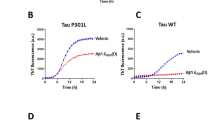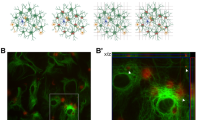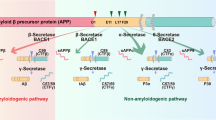Abstract
Amyloid-β (Aβ) peptides, found in Alzheimer's disease brain, accumulate rapidly after traumatic brain injury (TBI) in both humans and animals. Here we show that blocking either β- or γ-secretase, enzymes required for production of Aβ from amyloid precursor protein (APP), can ameliorate motor and cognitive deficits and reduce cell loss after experimental TBI in mice. Thus, APP secretases are promising targets for treatment of TBI.
This is a preview of subscription content, access via your institution
Access options
Subscribe to this journal
Receive 12 print issues and online access
$209.00 per year
only $17.42 per issue
Buy this article
- Purchase on Springer Link
- Instant access to full article PDF
Prices may be subject to local taxes which are calculated during checkout


Similar content being viewed by others
References
Maas, A.I., Stocchetti, N. & Bullock, R. Lancet Neurol. 7, 728–741 (2008).
Lenzlinger, P.M., Morganti-Kossmann, M.C., Laurer, H.L. & McIntosh, T.K. Mol. Neurobiol. 24, 169–181 (2001).
Zhang, X., Chen, Y., Jenkins, L.W., Kochanek, P.M. & Clark, R.S. Crit. Care 9, 66–75 (2005).
Mayeux, R. et al. Ann. Neurol. 33, 494–501 (1993).
van Duijn, C.M. et al. Am. J. Epidemiol. 135, 775–782 (1992).
Roberts, G.W., Gentleman, S.M., Lynch, A. & Graham, D.I. Lancet 338, 1422–1423 (1991).
Roberts, G.W. et al. J. Neurol. Neurosurg. Psychiatry 57, 419–425 (1994).
Ikonomovic, M.D. et al. Exp. Neurol. 190, 192–203 (2004).
Chen, X.H. et al. Am. J. Pathol. 165, 357–371 (2004).
Iwata, A., Chen, X.H., McIntosh, T.K., Browne, K.D. & Smith, D.H. J. Neuropathol. Exp. Neurol. 61, 1056–1068 (2002).
Blasko, I. et al. J. Neural Transm. 111, 523–536 (2004).
Cribbs, D.H., Chen, L.S., Cotman, C.W. & LaFerla, F.M. Neuroreport 7, 1773–1776 (1996).
Nadler, Y. et al. Glia 56, 552–567 (2008).
Uryu, K. et al. Exp. Neurol. 208, 185–192 (2007).
Matsuoka, Y. et al. Am. J. Pathol. 158, 1345–1354 (2001).
Mattson, M.P. et al. J. Neurosci. 12, 376–389 (1992).
Wyss-Coray, T. & Mucke, L. Neuron 35, 419–432 (2002).
Yankner, B.A. et al. Science 245, 417–420 (1989).
Esposito, L., Gan, L., Yu, G.Q., Essrich, C. & Mucke, L. J. Neurochem. 91, 1260–1274 (2004).
Rockenstein, E. et al. J. Biol. Chem. 280, 32957–32967 (2005).
Fox, G.B., Fan, L., Levasseur, R.A. & Faden, A.I. J. Neurotrauma 15, 599–614 (1998).
Brody, D.L. et al. Science 321, 1221–1224 (2008).
Thornton, E., Vink, R., Blumbergs, P.C. & Van Den, H.C. Brain Res. 1094, 38–46 (2006).
Cai, H. et al. Nat. Neurosci. 4, 233–234 (2001).
Duff, K. et al. Nature 383, 710–713 (1996).
Dovey, H.F. et al. J. Neurochem. 76, 173–181 (2001).
Abramowski, D. et al. J. Pharmacol. Exp. Ther. 327, 411–424 (2008).
El Mouedden, M., Vandermeeren, M., Meert, T. & Mercken, M. Curr. Pharm. Des. 12, 671–676 (2006).
Arumugam, T.V. et al. Nat. Med. 12, 621–623 (2006).
Acknowledgements
We would like to thank A. Pajoohesh-Ganji and P. Washington for technical assistance; S. Fricke and O. Rodriguez of the Small Animal Imaging Laboratory at Georgetown University; and P. Mathews (Nathan S. Kline Institute) for antibody C1/6.1. This work was funded by grant R03NS57635 (M.P.B.) and a pilot award from the National Capital Area Rehabilitation Research Network R24HD050845 (M.P.B.), both from the US National Institutes of Health, and by the Klingel Family Foundation (M.P.B.).
Author information
Authors and Affiliations
Corresponding author
Supplementary information
Supplementary Text and Figures
Supplementary Figs. 1 and 2 and Supplementary Methods (PDF 672 kb)
Rights and permissions
About this article
Cite this article
Loane, D., Pocivavsek, A., Moussa, CH. et al. Amyloid precursor protein secretases as therapeutic targets for traumatic brain injury. Nat Med 15, 377–379 (2009). https://doi.org/10.1038/nm.1940
Received:
Accepted:
Published:
Issue Date:
DOI: https://doi.org/10.1038/nm.1940
This article is cited by
-
Calpain inhibitor MDL28170 improves the transplantation-mediated therapeutic effect of bone marrow-derived mesenchymal stem cells following traumatic brain injury
Stem Cell Research & Therapy (2019)
-
Pharmacological inhibition of Notch signaling regresses pre-established abdominal aortic aneurysm
Scientific Reports (2019)
-
BACE1 elevation engendered by GGA3 deletion increases β-amyloid pathology in association with APP elevation and decreased CHL1 processing in 5XFAD mice
Molecular Neurodegeneration (2018)
-
Pulsatile stretch as a novel modulator of amyloid precursor protein processing and associated inflammatory markers in human cerebral endothelial cells
Scientific Reports (2018)
-
Traumatic Brain Injury Alters the Metabolism and Facilitates Alzheimer’s Disease in a Murine Model
Molecular Neurobiology (2018)



